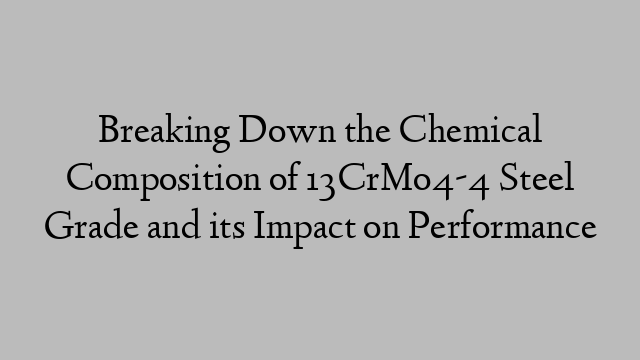Address
304 North Cardinal St.
Dorchester Center, MA 02124
Work Hours
Monday to Friday: 7AM - 7PM
Weekend: 10AM - 5PM
Address
304 North Cardinal St.
Dorchester Center, MA 02124
Work Hours
Monday to Friday: 7AM - 7PM
Weekend: 10AM - 5PM

The chemical composition of 13CrMo4-4 steel grade is crucial in determining its performance characteristics. This steel grade is primarily used in applications that require high temperature and pressure resistance, such as power plants and oil refineries. Understanding the breakdown of its chemical composition and how it affects its performance is essential for ensuring its suitability for specific applications.
The main elements in the chemical composition of 13CrMo4-4 steel grade are:
1. Carbon (C): Carbon content in steel affects its strength and hardness. Higher carbon content generally leads to increased strength, but also reduces ductility. The carbon content in 13CrMo4-4 steel is typically around 0.10-0.17%.
2. Silicon (Si): Silicon is added to improve the steel’s resistance to oxidation and scaling at high temperatures. It also enhances the strength and hardness of the steel. The silicon content in 13CrMo4-4 steel is typically around 0.10-0.40%.
3. Manganese (Mn): Manganese is added to improve the steel’s strength and toughness. It also promotes the formation of fine-grained structures, which enhance the steel’s ductility and impact resistance. The manganese content in 13CrMo4-4 steel is typically around 0.40-0.70%.
4. Phosphorus (P) and Sulfur (S): These elements are considered impurities in steel and should be kept as low as possible. Phosphorus can reduce the steel’s toughness and ductility, while sulfur can cause brittleness. The phosphorus and sulfur content in 13CrMo4-4 steel is typically limited to a maximum of 0.025%.
5. Chromium (Cr): Chromium is added to provide the steel with high temperature strength and corrosion resistance. It forms a protective oxide layer on the surface of the steel, which prevents oxidation and scaling at elevated temperatures. The chromium content in 13CrMo4-4 steel is typically around 0.70-1.15%.
6. Molybdenum (Mo): Molybdenum is added to improve the steel’s high-temperature strength and creep resistance. It also enhances the steel’s corrosion resistance to certain corrosive environments. The molybdenum content in 13CrMo4-4 steel is typically around 0.40-0.60%.
The impact of the chemical composition on the performance of 13CrMo4-4 steel grade can be summarized as follows:
1. High-temperature strength: The addition of chromium and molybdenum increases the steel’s high-temperature strength and creep resistance. This allows it to maintain its mechanical properties even at elevated temperatures, making it suitable for applications where high-pressure and high-temperature resistance are required.
2. Corrosion resistance: The presence of chromium and molybdenum enhances the steel’s corrosion resistance, particularly in environments containing hydrogen sulfide or other corrosive elements. This extends the service life of the steel in corrosive environments.
3. Toughness and ductility: The presence of manganese improves the steel’s toughness and ductility, making it more resistant to fracture and enabling it to withstand impact loading conditions.
In conclusion, the chemical composition of 13CrMo4-4 steel grade, particularly the addition of chromium, molybdenum, and manganese, plays a crucial role in determining its performance characteristics. By understanding the impact of these elements on the steel’s high-temperature strength, corrosion resistance, toughness, and ductility, engineers can ensure its suitability for specific applications.
13CrMo4 4 Steel grade
1698280375